Good Towns is a regular feature of Doing More Today, highlighting the people and places that make communities unique.
Sam Phillips was a dreamer. He started as a DJ, spinning easy-listening hits in a studio inside the basement of the Peabody Hotel before embarking on his own venture, Memphis Recording Services, where he had initial success putting hits on tape. That included “Delta 88,” arguably the first rock ‘n’ roll song.
There was just one problem: Phillips was merely a middleman. He got paid for the recording time but had no stake in the investment.
That led Phillips to another momentous move, opening Sun Studio and, within the first year, he had a hit record with Rufus Thomas’ “Bearcat.” Blues singers flocked there. But Phillips felt he needed diversity to reach wide audiences. His next gamble would prove the biggest of all.
In August 1953, Phillips had an opening on his schedule and agreed to his secretary’s wishes to let a recent high school graduate record a couple of tunes. Alas, the first two attempts on ballads were pretty dismal, leaving the 18-year-old singer to stalk the studio in frustration while strumming his guitar and singing an old blues number to vent.
Hold it, Phillips said. “That’s the sound I’ve been looking for.”
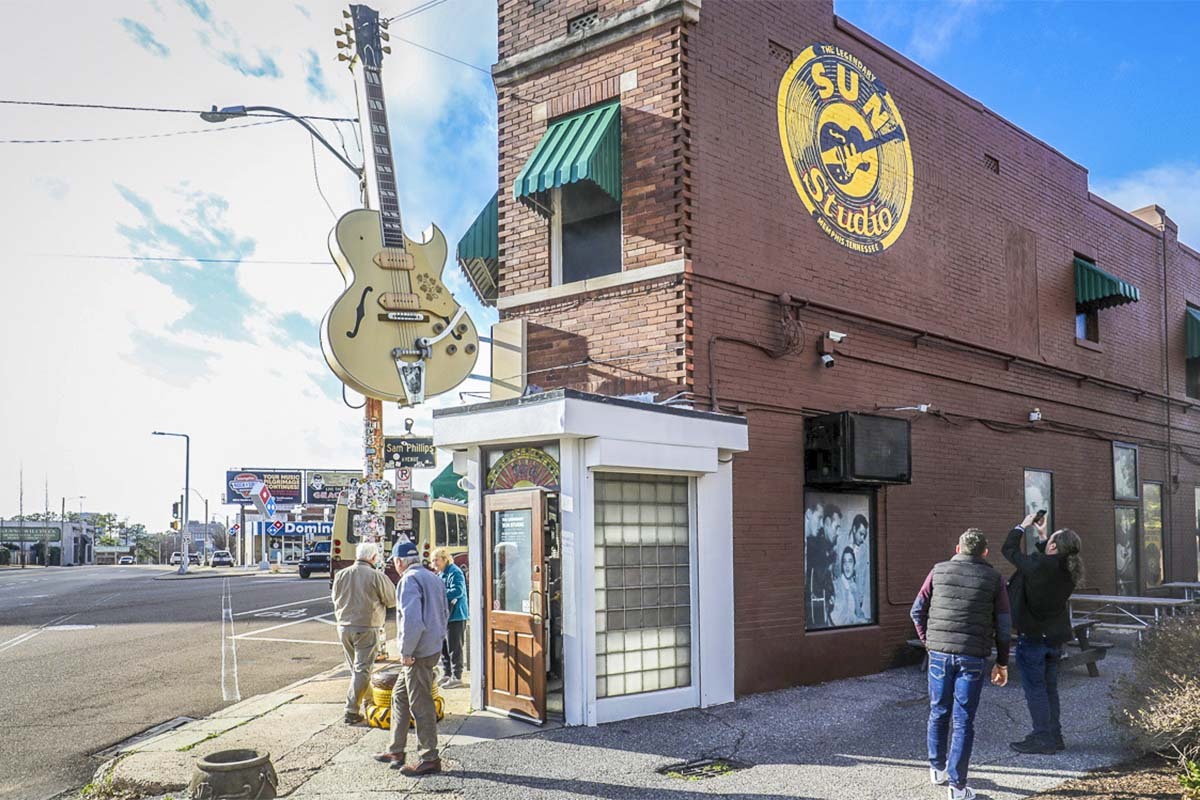
A tourist snaps a photo of the Sun Studio logo. / GARY TRAMONTINA PHOTOS

Tour guide Geoff Smith weaves tales of heartache and heavenly sounds at Sun Records.

Our tour guide fills us in on the incredible history of Sun Records.

Visitors at Sun Records view Dewey Phillips' radio studio, where the legendary DJ declared young Elvis Presley a rock-n-roll star.

Another view of Dewey Phillips' radio booth. It includes broken records on the floor. If Phillips didn't like a song, he broke the record into pieces.

Inside the Sun Records studio where the magic happened - from rock's first recording to the Million Dollar Quartet.

And that's how it was done. Geoff Smith uses a guitar to show us how Elvis recorded his first hit.
Just like that, a legend was born. Elvis Presley recorded, “That’s All Right.” And just three days later, DJ Dewey “Daddio” Phillips debuted the song on his radio show. As the phone lights lit up, Phillips played the song again and again, proclaiming a hit record.
Sun Records became the epicenter of recorded music, not only in rock but also in country. A few weeks before Christmas of 1956, four musicians held an impromptu jam session in the studios that would make history. It started as a recording session for Carl Perkins, who already had his first huge hit with “Blue Suede Shoes.”
Local musician Jerry Lee Lewis was hired to play the piano. Elvis, fresh off an appearance on the “Ed Sullivan Show” that fall, dropped in for a visit and immediately joined in. After they had a couple of songs under their belt, another local musician arrived for the chance to see Perkins work and he was asked to join in.
Johnny Cash said yes, and The Million Dollar Quarter was born. That pivotal moment in musical history remains as vivid today thanks to a musical that’s still popular on the theatrical circuit.
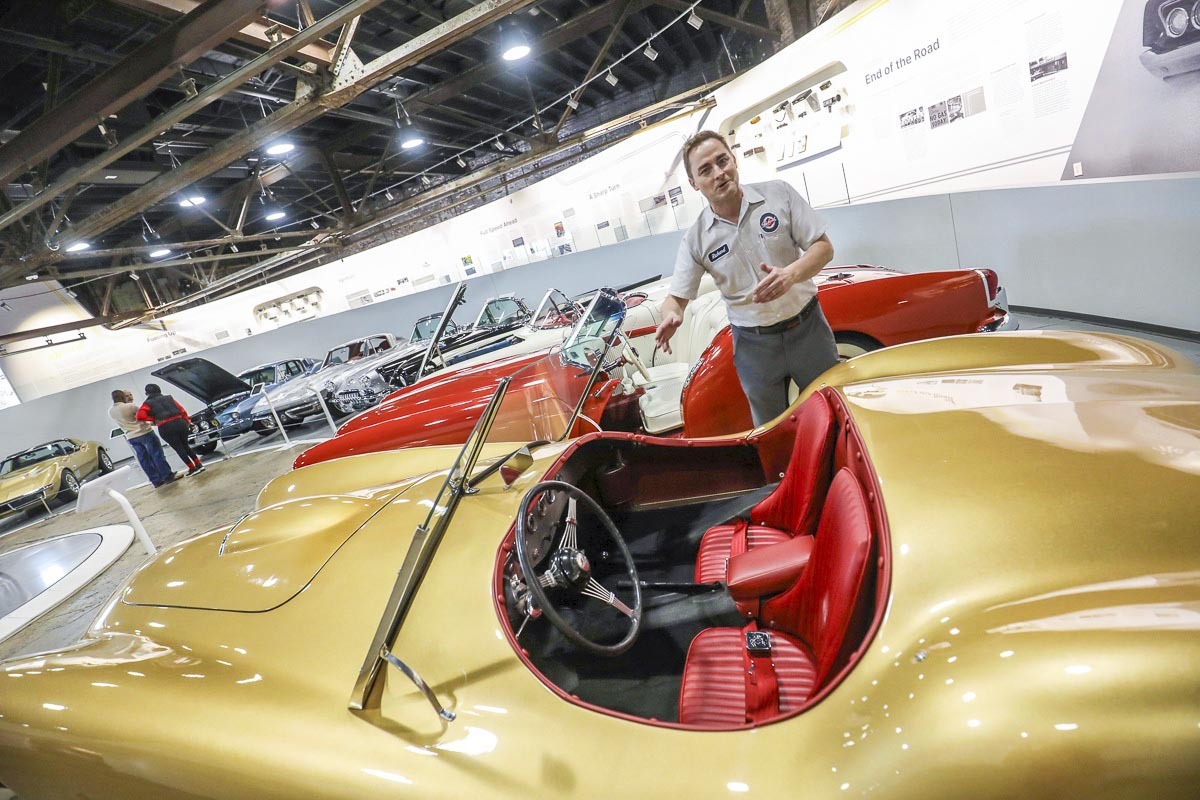
Richard Vining shows off the sleek 1951 Glasspar G2, which still looks hip 74 years in the future. / GARY TRAMONTINA PHOTOS

A gold-plated Rolls Royce with the iconic Spirit of Ecstasy hood ornament.

If you love cars, Edge Motor Museum is worth your time.
Get Your Motor Running
Just a block from Sun Studio is a relatively new addition to the city’s landscape, Edge Motor Museum, where you can spend an hour or a day perusing America’s legacy of classic cars.
“Originally, Cherokee Motors was housed here,” said Richard Vining, the founder and executive director the past six years. “That was from 1924-29, and this area became Memphis auto row.”
For six years, Edge Motor Museum has told our collective history through an assortment of eye-catching classic cars, beginning with an original 1913 Ford T Runabout.
But one of the first to catch our eyes is the 1951 Glasspar G2. Seventy-plus years after its production, the gold shell still shines. And that shell – made of fiberglass –set the Glasspar apart. It was the brainchild of a marine architect, William Tritt, who took the material used for popular boats of the area to the open road. The result, a hip roadster that became a favorite of Hollywood stars, including Humphrey Bogart and Gary Cooper.
Then there’s the 1951 Muntz Road Jet, built and designed by amateur engineer Earl “Madman” Muntz. The one here was the personal car of actress-singer Doris Day, replete with a cream color paint job and elaborate upholstered seats. Back then, the Jet’s asking price was $5,000, steeper than a Cadillac or Lincoln of the day. While the Muntz Road Jet’s heyday was short-lived, Muntz still enjoyed millionaire status thanks to his side gigs selling used cars and developing state-of-the-art television sets.
Touring the museum can take you back to the future in a DeLorean or provide a case-study of economic history by gazing at a multitude of Chevrolet’s iconic Corvettes.
“Since its inception, the Corvette was the economic barometer of this country,” Vining said. “For instance, 1983 was a rough year.”

The interior of the Crosstown Concourse, originally a Sears distribution center. / GARY TRAMONTINA PHOTOS

A former tour manager, Colin Dunning manages the Listening Lab, which contains thousands of albums, discs and CDs of music.

At the Crosstown Concourse, even stairs to the next level lead to a wonderful adventure.

With plush chairs and plenty of places to get lost in the music, the Listening Lab welcomes visitors daily. In the background, a ceramic statue of Nipper - the RCA dog - greets you.

Whatever you need, the Crosstown Concourse can provide - witness this art gallery.

Near the high school within the Crosstown Concourse, wooden bleachers offer the perfect place for study.
Mid-Century Magic
Memphis’ past merges with the modern in midtown, where a repurposed Sears distribution center has been transformed into the striking Crosstown Concourse.
What do you do with 1.5 million square feet, which had been abandoned for years? You offer retail space and art galleries, music venues and restaurants that provide the remedy for whatever your tummy craves. On the upper levels, there are apartments, condos and even a high school. In other words, you create a modern masterpiece.
“This site served as a key distribution site, one of 10 across the country, for years,” said Erin Shelton, Crosstown Concourse’s marketing director. “It was chosen because it was built at the crossroads of the city and its proximity to trains. At one point, Sears was the largest employer in Memphis.”
Alas, the retail store closed in 1983 and the distribution center shuttered a decade later. But what arose fulfills the initial purpose, to bring community together.
“The original developers of the project based their decisions on one distinct idea, ‘Life is lived Better Together,’” Shelton added.
Even on a rainy weekday, the place is packed. Shoppers peruse stores and students meander about after classes wrap up for the day. In a section of the complex called Crosstown Arts, Dan Reaves works with painstaking precision on a table he’s crafting for his daughter. What started as a part-time hobby after semi-retirement has become a full-flung adventure.
“I’ve been doing this for three years,” Reaves said. “During this time, I’ve made about 20 different pieces – tables, nightstands, coffee tables, bookcases and a desk. I just like working with my hands.”
And what did Reaves do before becoming an artisan?
“I was a surgeon,” Reaves said, humbly. “Some of this is very similar to surgery.”
Upstairs, you can find art galleries, the Green Room for live music, a bar with different themes throughout and the Listening Lab, where Colin Dunning, a former tour manager, shows off a never-ending library containing just about any modern recording.
“We’ve got 35,000 45s, 15,000 LPs and about 25,000 CDs,” Dunning said. “No matter your taste or your favorite artist, you can find what you want here.”
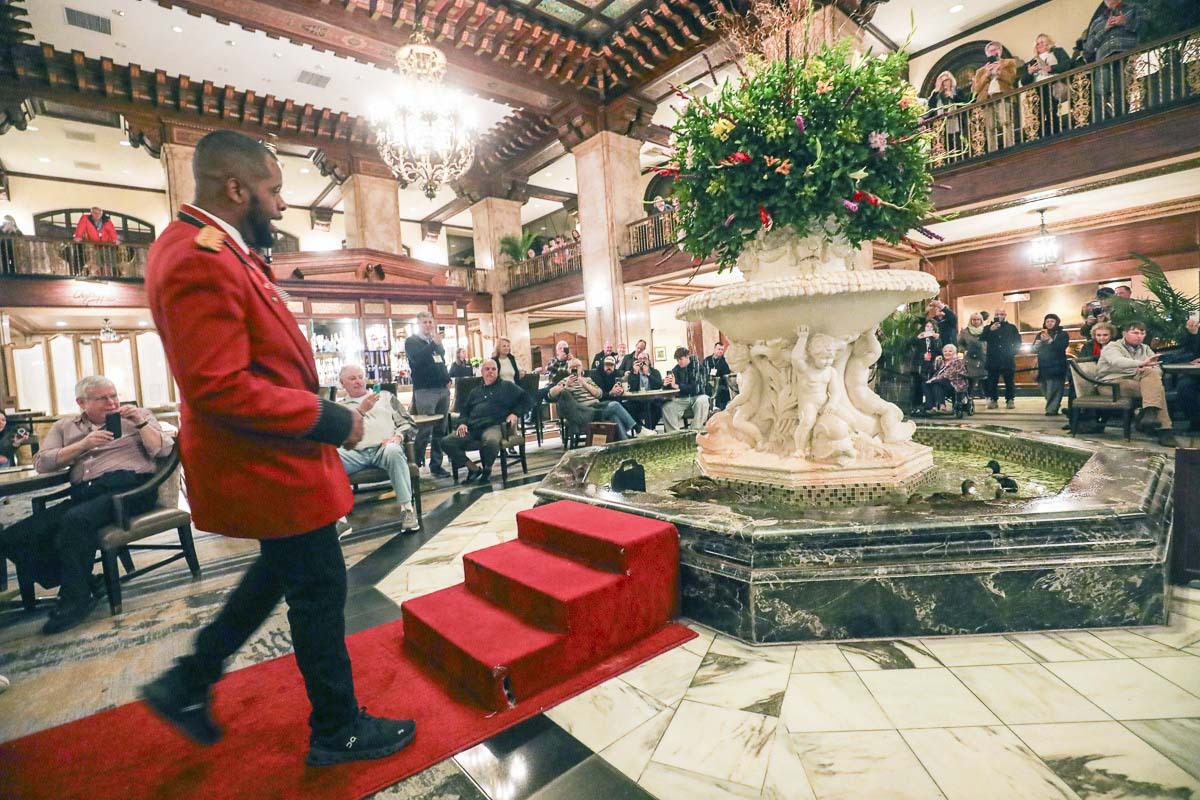
Duck master Kenon Walker proudly watches his flock enjoy their dip inside the fountain of the Peabody Hotel. / GARY TRAMONTINA PHOTOS

It's a blustery, windy day in Memphis. But atop the Peabody, Kenon Walker's ducks are ready to put on a show.

On the rooftop of the Peabody Hotel, Kenon Walker prepares his adorable team for their next performance.
The World’s Most Famous Ducks
Up on the roof of the iconic Peabody Hotel, Kenon Walker releases the hounds. Well, the famous Peabody ducks, actually. The daily procession begins in the skies above and when duck master Walker gives them their cue, the stars of the show walk excitedly across their open-air penthouse to a waiting elevator.
Let the show begin.
Downstairs in the lobby, guests line up for the procession that leads straight into a swim inside a water fountain. Armed with cell phones to video the moment, people smile and giggle as the adorable stars of the show make their way and take a daily dip.
Walker isn’t just the duck master. He has a theatrical background, and he serves as historian, regaling visitors with a story that’s known from coast to coast. It all started back 90 years ago when Peabody GM Frank Schutt and his friend Chip Barwick returned from a weekend Arkansas hunting trip with some live decoys.
Motivated by some smooth Tennessee sippin’ whiskey, Schutt and Barwick placed three English call ducks in the base of the fountain. What was intended as a practical joke instead became an institution. By 1940, the ducks were making their choreographed entrance. Today, Walker maintains the magic, arriving early to get guests to unroll the red carpet and while providing a quick lesson before the show begins.
If you’ve seen it once or a dozen times, you still feel the magic of a little kid.
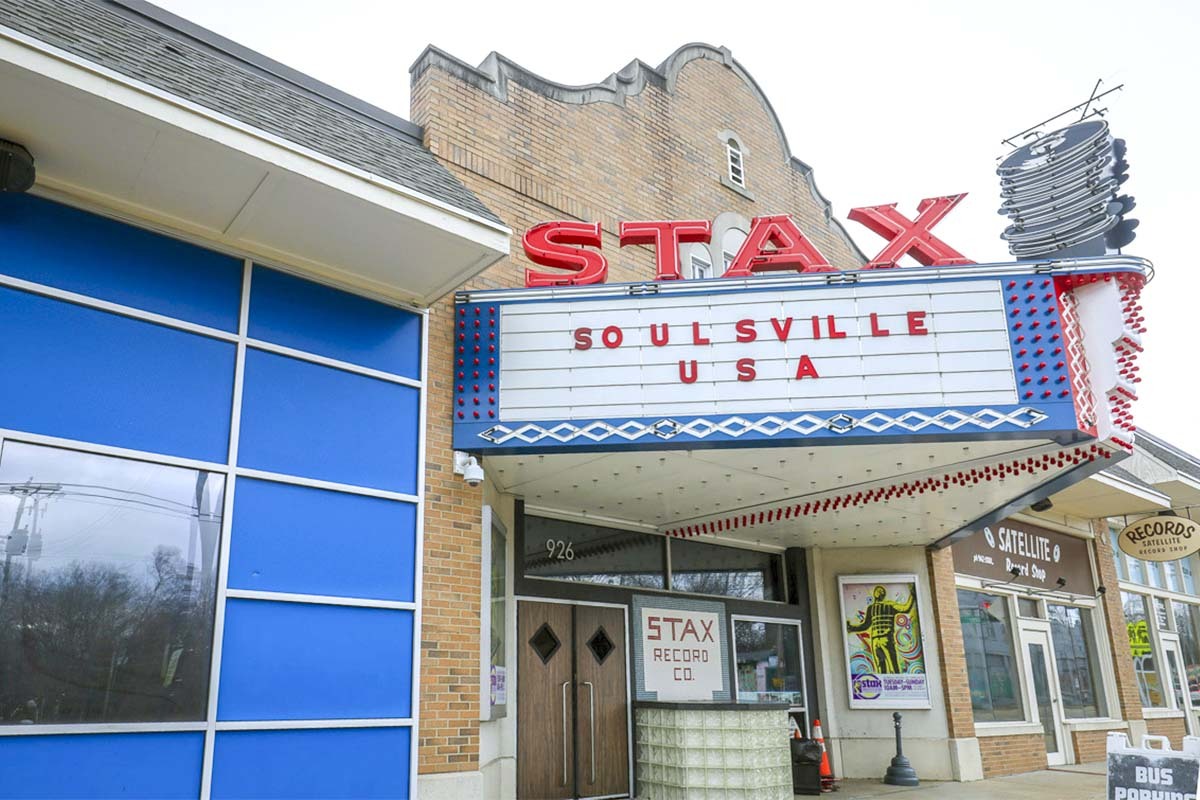
The marquee of Stax, which rivaled Motown during the 1960s and '70s. / GARY TRAMONTINA PHOTOS

Kirby Boyd and Lauren Berry are all smiles outside the Beauty Shop, a one-time hair salon that's now a popular eatery.

At the Stax Museum of American Soul Music, visitors are greeted by the hundreds of albums produced by the record label.

A sweater at the Stax museum shows off the Booker T & the M.G.'s logo.

A clip of "Soul Train" plays in the theater. Don Cornelius' epic dance show played a key role in the label's rise to prominence.

Legendary guitars played by even more famous Stax musicians.
Hot-Buttered Soul
Detroit had Motown, where the city folk crafted smooth R&B. But here, Stax Records emerged in the late 1950s to create the branded Memphis Sound blending the blues with hot-buttered soul.
And for 15 years, Stax Records dominated the air waves. Motown had Smokey and the Temptations. Stax produced Hayes and Rufus Thomas, Booker T and the MGs. And at the height of Stax’ reign, an up-and-comer named Otis Redding joined the roster.
When Redding toured Europe in 1967, crowds greeted him with a clamor no one had seen since the Beatles came on the scene. Concert dates across the continent were packed, and his “Live from Europe” album hit stores that December, mesmerizing listeners.
His greatest hit, “Sitting on the Dock of the Bay,” a song that he said the Beatles inspired but many believed was too much of a departure from his trademark style, was recorded when he got back to the states. The song would become a classic posthumously. On a concert tour in Wisconsin, Redding’s plane went down in Lake Monona amid a storm, taking his life.
Without Redding, Stax continued for another decade until financial problems plagued the studio. Today, the label’s incredible story is told daily at the Stax Museum of American Soul Music, where the short tour will get your heart racing and your feet tapping.
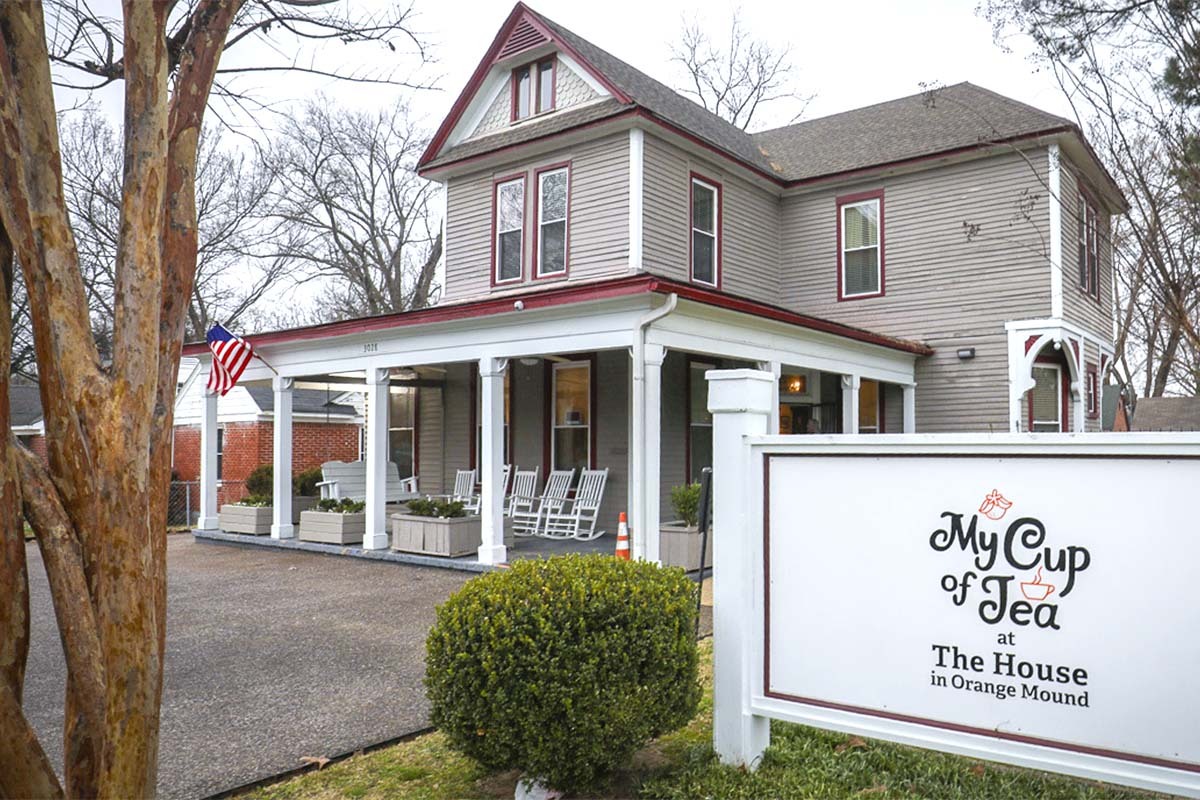
My Cup of Tea sits in the heart of Orange Mound, one of Memphis' most historic neighborhoods. / GARY TRAMONTINA PHOTOS

My Cup of Tea is more than a successful business. It's a mission to help women of the historic Orange Mound neighborhood break free of systemic inequality.

Carey Moore and her husband founded My Cup of Tea as part of their Christian missionary work.

The work at My Cup of Tea is helping reshape lives.

Carey Moore visits with her team as they prepare boxes of My Cup of Tea that will ship all across the globe.

Linda Allen shows off three boxes of My Cup of Tea that are ready for retail distribution.
The Caviar of Tea
The historical Orange Mound area in southeast Memphis was the first American neighborhood built by African Americans. But as Memphis grew in all directions, opportunities in Orange Mound withered.
Fifteen years ago, Carey Moore and her husband vowed to do something to revitalize the community. Long involved in Christian missions across the world, The Moores returned to their hometown intent on making a difference.
“Orange Mound suffered from decay,” Carey Moore said. “Jim Crow laws impeded growth and only people in transition would go here. When we learned of this property and began asking around, a friend said these people just need a job and an opportunity. So, we hoped to provide one with My Cup of Tea.
My Cup of Tea brings blends from across the world and distributes its product internationally.
“We hire just women, women who want a job, dignity and a better opportunity,” Moore added. “I believe very sincerely that we are called to trust the Lord and so something positive.”
Since its inception, My Cup of Tea has not only provided jobs but has served as beacon for the community. The former blight is evaporating block by block. New houses, which My Cup of Tea helped finance, are going up. While helping ignite the Orange Mound economy, My Cup of Tea has also served as a catalyst for others to help – 25,000 meals provided by volunteers, ensuring no one at My Cup of Tea goes hungry.
“Our product is at a caviar-champagne level,” Moore said. “Our ladies are experts on the nuances of our tea.”
My Cup of Tea has spawned other local businesses. In Deborah Chalmers’ case, it may have saved her life.
Diagnosed with an autoimmune disease, she was disabled in 2010. Two years later, she was told she would never walk again.
“One day in 2014, I got tired of sitting on my porch in a wheelchair,” Chalmers remembered. Something told me to get up and walk. I did, and I was led here. My first thought was that it was a place for people with problems. But they had a Bible Study, and I started coming regularly. And then I started showing up on Saturdays and Sundays to help. I found my purpose.”
That led her to create Deborah’s Creations, which operates out of the top floor of the My Cup of Tea building. It inspired her to share her mastery of a needle, thread and a sewing machine with others trying to forge a new life.”
And now, a decade after she was told her life was essentially over, Chalmers has purpose again, one she shares daily to inspire others.

At the National Civil Rights Museum, the Lorraine Motel exterior looks the same as it did on an infamous April day in 1968. / GARY TRAMONTINA PHOTOS

Vintage cars line the parking lot and a wreath commemorates the spot where Dr. Martin Luther King Jr. lost his life.

At a vintage diner, statues of protesters commemorate the sit-ins that helped advance the fight for equality.

The Lorraine Motel's Room 306 is encased in glass to commemorate Dr. Martin Luther King Jr.'s final day.

Another key moment of the Civil Rights Movement: Alabama state troopers block the entrance to the Edmund Pettus Bridge in Selma.

Sculptures and a Montgomery City bus help bring Rosa Parks' stand for equality to life.

A working bus commemorates Rosa Park's refusal to give up her seat in Montgomery, a key catalyst of the Civil Rights movement.

Visitors at the National Civil Rights Museum at the Lorraine Motel study a display that details the beginning of the slave trade to the U.S.
Memphis, Tennessee: Where History and Hope Collide
You enter the National Civil Rights Museum at the Lorraine Motel by walking past vintage cars and the original lodging. It’s a facade stuck in time – April 4, 1968, specifically, the day an assassin’s bullet took the life of Dr. Martin Luther King Jr. as he gazed up, outside his room, on the second floor of the Lorraine.
What sets this museum apart is that it focuses on 200-plus years of history. It traces the history of African Americans from their arrival to the U.S. on slave ships. It includes interactive rooms focusing on the frontlines of the Civil Rights Movement, from Selma to Montgomery, and from Birmingham to that early evening, April 4, when shots rang out in the Memphis sky.
But the museum also serves as a gateway to the future. Memphis continues to inspire. New businesses and old global industries shape this city on the mighty Mississippi River. Tourists continue to visit by the hundreds of thousands due to offerings. There’s world-class food, outdoor options galore and, if you’re a basketball fan, a hoops heaven. That includes the powerhouse Memphis Tigers at the collegiate level, the NBA’s Memphis Grizzlies and some of the best prep talent in the world.
As David May, Regions’ market executive for the city and head of Commercial Banking for the Mid-America district, said, “there’s more to Memphis than barbecue and Elvis.”
Thank you, thank you very much.
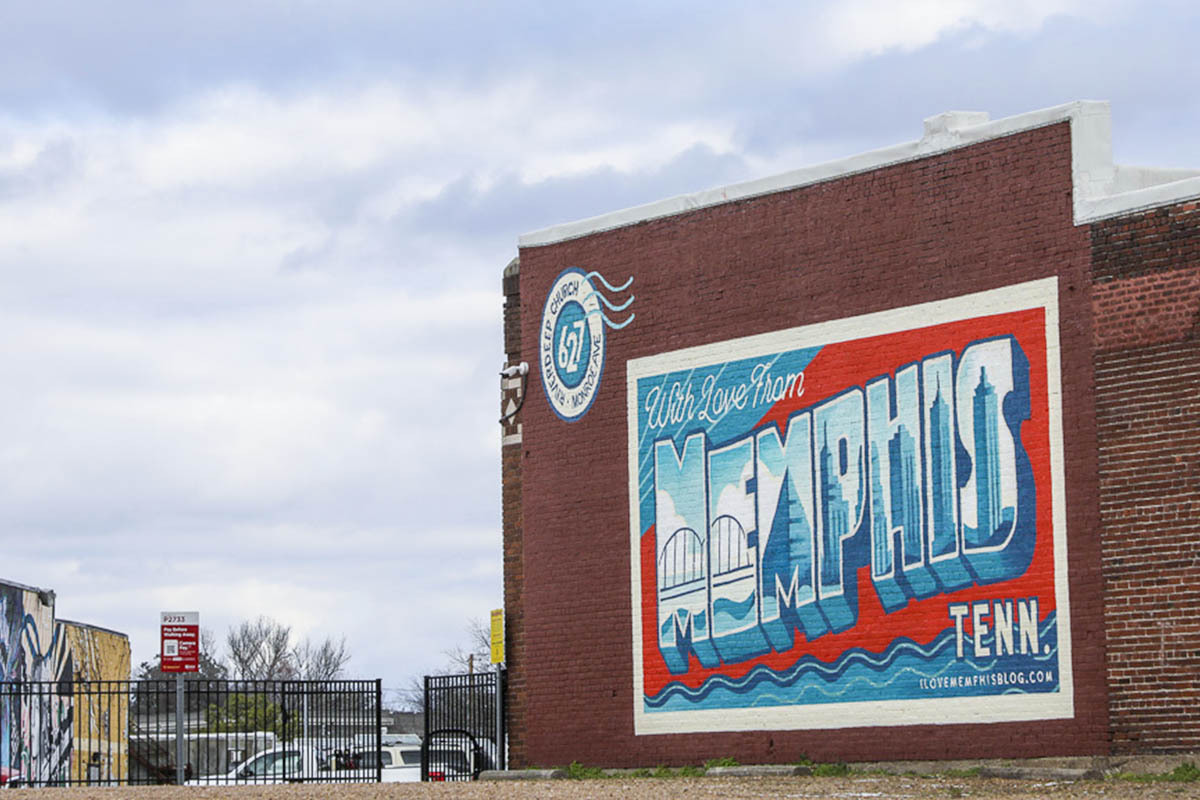
A mural of a giant postcard touting Memphis welcomes you near Edge Motor Museum. / GARY TRAMONTINA PHOTOS

Dubbed the home of the blues, Beale Street continues to draw visitors by the millions.

Sidewalk poetry from a local artist greets you with a thoughtful message.

A sign at the Germantown Commissary provides a teasing reminder that the greats of music know the restaurant well.

Cheese-covered onion rings at the Germantown Commissary.

The Farmer's Market warm salad with pan-roasted Barramundi at the Beauty Shop, a beloved restaurant.

At Blues City Café on Beale Street, our day is made by gumbo, grilled shrimp and an appetizer of fried mushrooms.

Barbecue is synonymous with Memphis. At the Germantown Commissary, we found this delightful mix of sweet and tangy deliciousness.

From Big River Crossing, one can take in Memphis' downtown and the Bass Pro Hotel, which began life as a sports and entertainment arena.

Another well-known mural in downtown Memphis commemorates the city's past in the Civil Rights movement.

In a studio on the second floor of My Cup of Tea, Deborah Chalmers creates artistic crafts that sell all over the world.

Colorful, artistic graffiti tells stories and provides a friendly welcome near Sun Records.

A jogger hustles across the Big River's steel pathway on a sunny spring day.

Big River Crossing stretches a mile across the Mississippi River and is the longest pedestrian crossing over the Big Muddy.
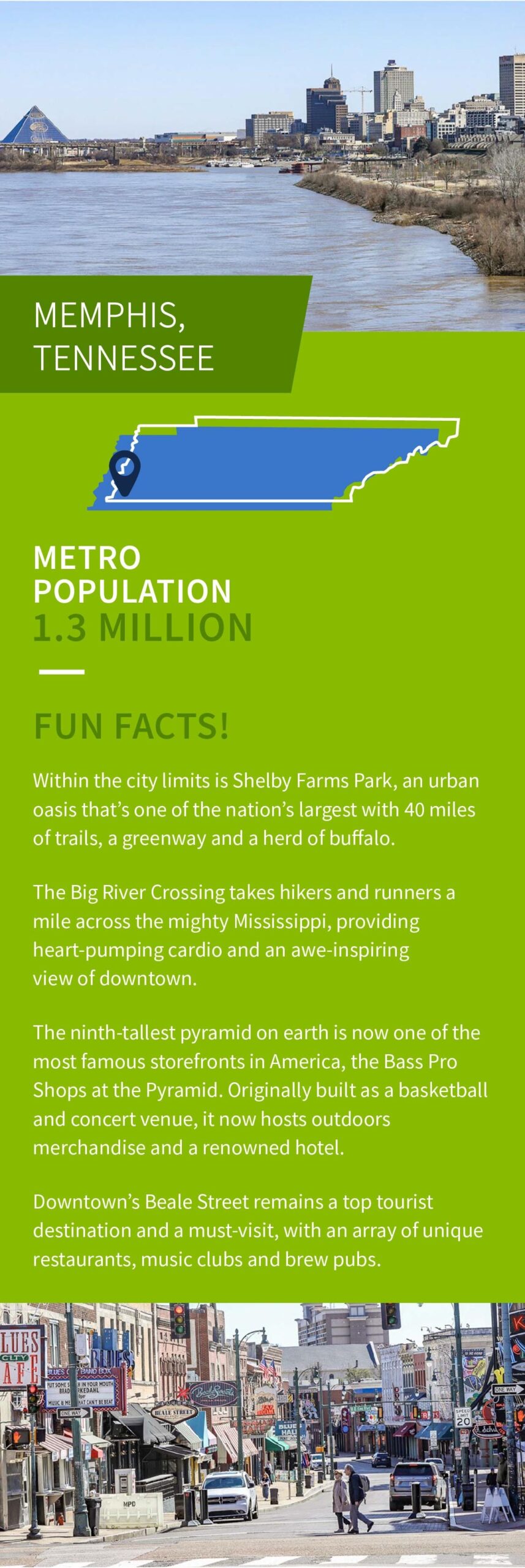 GARY TRAMONTINA PHOTOS
GARY TRAMONTINA PHOTOS